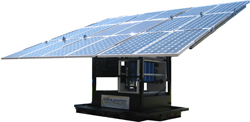
Combating one of Mother Nature’s overlooked assassins: dirty water
Washington, D.C. residents know better than to drink the muddy, brackish water straight from the banks of the Potomac River. But at a recent demonstration, the CEO of a company working to develop a high-powered water filter did just that…and lived to tell about it.
World Water and Solar Technologies was one of several companies that responded when the Department of Homeland Security’s (DHS) Science and Technology Directorate (S&T) issued an Operational Requirements Document (ORD) for a self-contained, self-powered water purification system. Their MaxPure is both.
Purging water of parasites, viruses, bacteria and other grunge is nothing new. But unlike the fuel-guzzling, generator-driven systems of yesteryear, S&T is seeking a portable and self-sustaining purifier, one that would lend itself to ready usage on a stand-alone basis.
The ORD was released in April 2009 through an S&T public-private partnership known as SECURE (System Efficacy through Commercialization, Utilization, Relevance and Evaluation). The document attracted the attention of WorldWater and seven other small businesses: Aqua Sciences, RescueWater, Wellspring Trailer Group, First Water, Spectra Watermakers, PureSafe Water Systems and Alten Energy Solutions.
Today, all eight firms actively are honing their systems to the ORD’s specifications. When testing is complete, each firm will deliver its data to S&T. If the technology passes muster, S&T will certify it and the firms can start marketing their wares using the all-important SECURE insignia.
“The SECURE seal of approval helps to guide emergency managers who purchase water purification systems,” says Mary Hanson, S&T’s interagency coordinator.
When a hurricane, earthquake or wildfire strikes, a variety of supplies and equipment are needed to respond and aid victims. But clean water is a common denominator; its demand is chronic and ubiquitous. In fact, dirty water is one of Mother Nature’s overlooked assassins. More than one million people perish each year after imbibing it, and according to the World Health Organization, more than one billion people lack access to its clean counterpart. The solutions sought by S&T seek to rectify such preventable tragedies.
A peek at some of the proposed solutions shows the SECURE program in action—tapping the free market’s ingenuity for the public’s benefit.
Consider the Spectra-Pearson Pump from Spectra Watermakers. As it happens, the Spectra pump provides the desalination technology behind the MaxPure. Unlike conventional systems, which consume 35-50 watts of electricity per gallon, the Spectra demands only 8-9 watts per gallon. (For 10 gallons of brackish water pumped, you get roughly one gallon of potable water.) While such levels of efficiency are common at industrial-size reverse-osmosis plants, the Spectra-Pearson can fit into a suitcase. And whereas high-pressure pumps and energy recovery systems typically are two separate entities, the Spectra-Pearson integrates them into one lean, mean machine.
Another SECURE aspirant, RescueWater from Water of Life, prides itself on going anywhere there is freshwater—water mains, lakes, rivers, wells, and so on. Powered by propane, its submersible pump needs no priming, and can be deployed to a depth of up to 50 feet. In fewer than three minutes, RescueWater can start disinfecting pathogens, so much so that this 250-pound machine can purify up to 17,000 gallons of pristine water per day.
Finally, there’s WorldWater’s MaxPure. Whatever the state of the local infrastructure, this lightweight and portable water purifier can be flown in by helicopter or towed in by pick-up truck. Its seven cubic feet and 6,200 pounds arrive on its own trailer, which can be parked alongside any water source, as long as it gets sunlight. Stick the system’s pump in the water, flip a switch, and within 20 minutes you’ll have a flow of thirst-quenching, life-saving agua.
At full capacity, the MaxPure can generate up to 30,000 gallons a day.
How does the MaxPure work this liquid magic? As with many of life’s good things, with help from the sun. For daily operation, the MaxPure needs five hours of sun exposure. Its six-foot by three-foot grid of solar panels can pocket the leftover exposure into a 31 kWh battery bank for cloudy conditions. The panels generate electricity, powering the pump to draw the water through a series of hoses and filters before storing it in a 2,500-gallon tank.
The end result: Potable H20. The net cost: a penny a gallon.
“The SECURE program is pushing companies to compete at producing lifesaving innovations,” reflects S&T’s Hanson. “And purifying large amounts of water when its needed most won’t just save lives, it could save communities.”
The beneficiaries of this S&T project no doubt will drink to that.
To request more information about this story, please e-mail st.snapshots@hq.dhs.gov.
